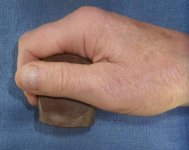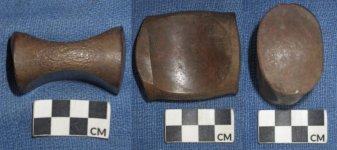DoctorWhy
Full Member
Searching around a homesite that has been continually occupied since it was built in the mid-1800s, I came across this artifact. It was buried about 9" beneath a sizable tree root -- and rang up as a solid, loud and clear "95" on the Garrett Pro...
In earlier years there might have been a blacksmith's shop on the property. In the 1950's through 1990's there was a silver/goldsmith living at the residence.
This heavy brass object fits comfortably in the hand, as if it were used as a mallet or pounder of some sort. Internet searches have not turned up anything similar.
Anybody have an idea of what it might be? Could my thought that it might have been a 'pounder' or mallet used by a silver-/gold-smith or engraver be a reality?
Thanks and happy hunting!
--Bert
In earlier years there might have been a blacksmith's shop on the property. In the 1950's through 1990's there was a silver/goldsmith living at the residence.
This heavy brass object fits comfortably in the hand, as if it were used as a mallet or pounder of some sort. Internet searches have not turned up anything similar.
Anybody have an idea of what it might be? Could my thought that it might have been a 'pounder' or mallet used by a silver-/gold-smith or engraver be a reality?
Thanks and happy hunting!
--Bert





